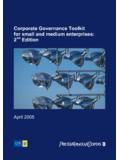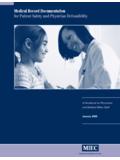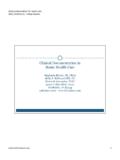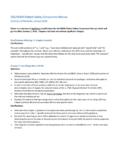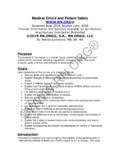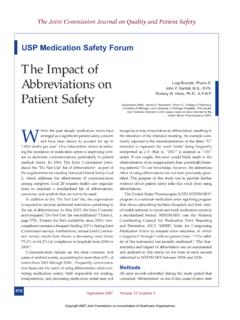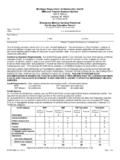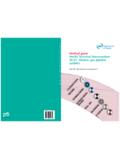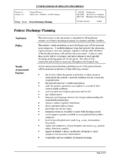Transcription of Reviewed articles The risk and consequences of …
1 HEALTH INFORMATION MANAGEMENT JOURNAL Vol 38 No 1 2009 ISSN 1833-3583 (PRINT) ISSN 1833-3575 (ONLINE) 35 Reviewed articlesThe risk and consequences of clinical miscoding due to inadequate medical documentation:a case study of the impact on health services fundingPing Cheng, Annette Gilchrist, Kerin M Robinson and Lindsay PaulAbstractAs coded clinical data are used in a variety of areas ( health services funding, epidemiology, health sciences research), coding errors have the potential to produce far-reaching consequences . In this study the causes and consequences of miscoding were Reviewed . In particular, the impact of miscoding due to inadequate medical documentation on hospital funding was examined. Appropriate reimbursement of hospital revenue in the casemix-based (output-based) funding system in the state of Victoria, Australia relies upon accurate, comprehensive, and timely clinical coding. In order to assess the reliability of these data in a Melbourne tertiary hospital, this study aimed to: (a) measure discrepancies in clinical code assignment; (b) identify resultant Diagnosis Related Group (DRG) changes; (c) identify revenue shifts associated with the DRG changes; (d) identify the underlying causes of coding error and DRG change; and (e) recommend strategies to address the aforementioned.
2 An internal audit was conducted on 752 surgical inpatient discharges from the hospital within a six-month period. In a blind audit, each episode was re-coded. Comparisons were made between the original codes and the auditor-assigned codes, and coding errors were grouped and statistically analysed by categories. Changes in DRGs and weighted inlier-equivalent separations (WIES) were compared and analysed, and underlying factors were identifi ed. Approximately 16% of the 752 cases audited refl ected a DRG change, equating to a signifi cant revenue increase of nearly AU$575,300. Fifty-six percent of DRG change cases were due to documentation issues. Incorrect selection or coding of the principal diagnosis accounted for a further 13% of the DRG changes, and missing additional diagnosis codes for 29%. The most signifi cant of the factors underlying coding error and DRG change was poor quality of documentation. It was concluded that the auditing process plays a critical role in the identifi cation of causes of coding inaccuracy and, thence, in the improvement of coding accuracy in routine disease and procedure classifi cation and in securing proper fi nancial (MeSH):Clinical Audit; Diagnosis-Related Groups; Medical Errors; Case Mix; Funding; Hospitals; Hospital Administration; Australia; Clinical Coding36 HEALTH INFORMATION MANAGEMENT JOURNAL Vol 38 No 1 2009 ISSN 1833-3583 (PRINT) ISSN 1833-3575 (ONLINE) Reviewed articlesIntroductionIn Australia, as in some other Western countries, coded clinical data are held in databases which are subsequently accessed for a variety of purposes.
3 The applications to which coded hospital data are directed obviously drive the need for accuracy and reliability of clinical coding, and for the development of instru-ments to detect coding errors. The provision of appropriate funding of hospital services via the casemix-based funding model, for example, depends upon the reliability of grouping of medical conditions and procedures into Diagnosis Related Groups (DRGs), which is dependent upon the accuracy of clinical coding, and this in turn relies upon the quality of clinicians documenta-tion. Health statistics which inform social and medical research and health policy development are used under the assumption that they are accurate. Monitoring of information provided through coded medical records, for example the incidence and nature of complications, is essential to patient safety, the conduct of quality manage-ment and clinical risk management programs, and the construction of hospital performance importance of coding accuracy: a review of the literatureWhen writing about hospital morbidity data on antibiotic resistance in Australia, Hargreaves and Kok (2003: S55), observed: The national introduction of the Australian versions of ICD-9-CM in 1995, and of casemix-based funding and management from the mid-1990s, has possibly led to more accurate medical record documen-tation and improved coding of these infections and are likely explanations for the observed increase in reporting.
4 These secondary benefits of casemix funding which are derived from its associated clinical coding cannot, however, be embraced without scrutiny. More than a decade ago MacIntyre, Ackland and Chandraraj conducted a review of hospital medical records designed to determine the accuracy of the injury data held in the Victorian Inpatient Minimum Database which were obtained from hospital morbidity data from public hospital separations with ICD-9-CM principal diagnosis codes 800-999. The findings lead the authors to observe that although coded data as a source of injury surveil-lance data are valuable (and as it happened in this case, reliable), there is always the possibility that the database could be compromised through the limitations of coded hospital morbidity data (MacIntyre, Ackland & Chandraraj 1997: 779; see also MacIntyre et al. 1997). We note that these can include limitations of the coding system, including the standards and conventions, as well as potential coding issues surrounding coding errors have long been recognised, and despite the fact that their consequences can be far-reaching there remains a paucity of literature on the matter of clinical coding audits themselves.
5 Most of the literature on the theory of auditing deals with the auditing of financial processes and systems in use in various businesses (La Trobe University 2006). However, health care is very costly and it is essential for the financial viability of individual hospitals that they are appropriately reimbursed for the costs of the care and services they provide their patients. The concern of the current study was to determine the frequency and possible causes of miscoding in a large tertiary hospital in Melbourne, and to examine the impact of coding errors on the hospital s funding via the casemix model. The following review of the literature covering the years 2000 to 2008 (by which time the employment of DRGs had become well-established), nevertheless indicates that there is increasing concern about the frequency and sources of coding errors and the need to minimise pause to emphasise here that for the purposes of this study we are focusing on the principles rather than the idiocyncrasies of the different systems; that is, we are not comparing systems such as ICD-9, ICD-9-CM, ICD-10 and of miscoding: funding of health servicesThat the accuracy of clinical coding is crucial to the appropriate funding of health services when the funding mechanism is based on DRGs (casemix) has been demonstrated by Curtis, Bollard and Dickson (2002).
6 In an investigation into the accuracy of clinical information coding in an Australian tertiary trauma centre, they showed that of 100 records Reviewed , 28% required HEALTH INFORMATION MANAGEMENT JOURNAL Vol 38 No 1 2009 ISSN 1833-3583 (PRINT) ISSN 1833-3575 (ONLINE) 37 Reviewed articleschanges to their DRGs, resulting in a substantial increase in funding. Interestingly, the authors recognised the clinical documentation skills of nursing staff when they wrote that [t]he validity of coding is dependent on legible, comprehensive and complete documentation and is improved dramatically by using nursing case managers patient progress summaries (Curtis, Bollard & Dickson 2002).The importance of the documentation and coding of additional diagnoses is stressed by Reid, Allen and McIntosh (2005). A coding audit (non-blind) described by these authors was designed mainly to check that all additional diagnoses for leukaemia, non-acute leukaemia and lymphoma had been recorded, coded and therefore claimed for by a Sydney hospital during the fiscal year 2000-2001.
7 A gold standard coder Reviewed and adjudicated on those cases where the auditor did not concur with the original coder. The authors found that there were fewer high-complexity episodes in the year under study. They also found that under-coding of complications and/or comorbidities was more frequent than over-coding, resulting in overall under-funding. A study by Marshall and Adema (2005) found that the overall coding error in a health system in Florida was , with a consequent significant loss of funding. The facility introduced a number of measures to correct these errors, including a daily review of coding by coding experts. (See also Adams, Norman & Burroughs 2002; Fillit et al. 2002).Service providers, however, are not alone in their concern about the link between accurate coding and correct funding. In the USA, Wachter, Foster and Dudley (2008) report the use of coding to identify (and stop payment for) preventable conditions ( bedsores, ulcers) which arose as a result of poor patient management, by the introduction of a new approach to coding for pre-existing conditions.
8 The strategy in this case was to improve patient care and safety by penalising the facility for poor care. In this instance, patient safety and funding had become errors can occur beyond the hospital environment; for example mortality coding from death certificates can have far-reaching policy and financing consequences . An unexpected outcome of racial bias in coding cause of death data which was also linked to funding inequity, was revealed in a study by Graber et al. (2005) who found that the incidence of cardiovascular disease (CVD) mortality among Maine American Indians had been underestimated. Correction of the coded data showed that incidences had been misclassified ( coding errors; data entry errors). As a result it was realised that the rate of CVD was in fact constant across the population, and funding for the condition in the indigenous population was then duly the primary concern of this study was the effect of coding inaccuracy on the funding of health services, the following reveals that there are other important effects of miscoding which, like the previous two examples, are sometimes linked to of miscoding: hospital performance or league tablesIn Australia, coded patient discharge records are fundamental to planned national strategies designed to improve patient safety and quality of care (National Health and Hospitals Reform Commission 2008).
9 A coding audit in a multi-speciality urological clinic in the USA conducted by Ballaro, Oliver and Emberton (2000: 389) revealed a high rate of coding inaccuracy by urology clinician trainees, to the extent that the authors claimed that the clinical codes generated from the authors department do not accurately reflect the clinical practice . They state therefore that any perfor-mance tables based upon routine clinical data would be unreliable. Jameson and Reed (2007) also stressed the importance of accuracy in coded data which are used in the construction of league tables in the UK. (See also Berridge 1998).1 consequences of miscoding: surveillance and epidemiologyHospital discharge data are a critical resource for disease surveillance programs, which in turn are used to inform disease prevention and other public health programs. Schoenman et al. (2008: 455), for example, list public health applications of hospital discharge data in the USA 1 For examples of hospital league tables in the UK see: and in Australia, see: HEALTH INFORMATION MANAGEMENT JOURNAL Vol 38 No 1 2009 ISSN 1833-3583 (PRINT) ISSN 1833-3575 (ONLINE) Reviewed articlesas disease surveillance and prevention, economic burden-of-illness studies, public health reporting and environmental health.
10 They note that the users of these databases are diverse, including government agencies, provider associations and individual providers, consumer organizations and patients, health care insurers and other purchasers ( large organizations and patients, health care insurers and other , policy makers, researchers, and private-sector interests, such as database vendors and consul-tants [2008: 453-4]).As Moje, Jackson and McNair (2006: 333) point out in their study of the accuracy of injury coding in Victorian hospitals: The usefulness of abstracted data for quality and safety purposes relies on good documentation in the medical record, thorough coding and periodic data audit . McCarthy et al. (2000: 868), when referring to coding in California and Connecticut of complications such as post-operative acute myocardial infarction, found that the coding was at times inaccurate (or missing), resulting in under-funding and also raising concerns about the clinical validity of using ICD-9-CM codes for quality monitoring.

